Comprehensive Financial and Strategic Analysis of Emirates Airline
VerifiedAdded on 2020/01/07
|23
|5935
|239
Report
AI Summary
This business analysis project examines Emirates Airline's financial performance and strategic positioning within the airline industry. The report begins with an introduction outlining the purpose of the study, the case context, and the company's background, followed by a discussion of key issues. A detailed financial analysis compares Emirates with competitors like Lufthansa and International Consolidated Airlines (ICA), covering revenue, market share growth, profit margins, price-earnings ratio, debt levels, and cash ratios. The report also includes a strategic analysis using Porter's Five Forces model and a balanced scorecard to assess the competitive environment. The limitations of financial models and conventional analysis are also discussed. The analysis highlights Emirates' strengths, weaknesses, and areas for improvement, providing recommendations based on the findings. The report concludes with a comprehensive overview of the airline's performance and strategic direction.
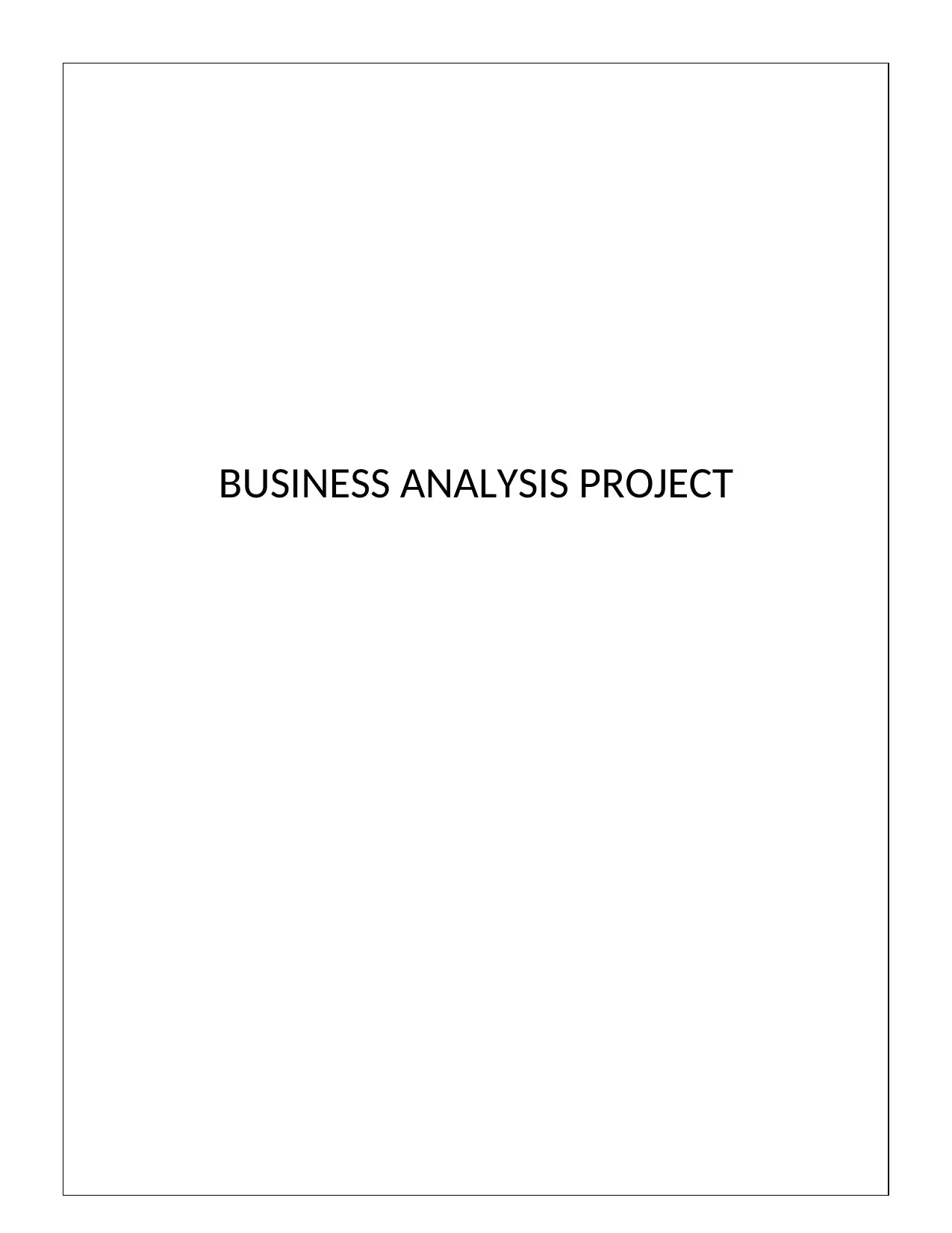
BUSINESS ANALYSIS PROJECT
Paraphrase This Document
Need a fresh take? Get an instant paraphrase of this document with our AI Paraphraser
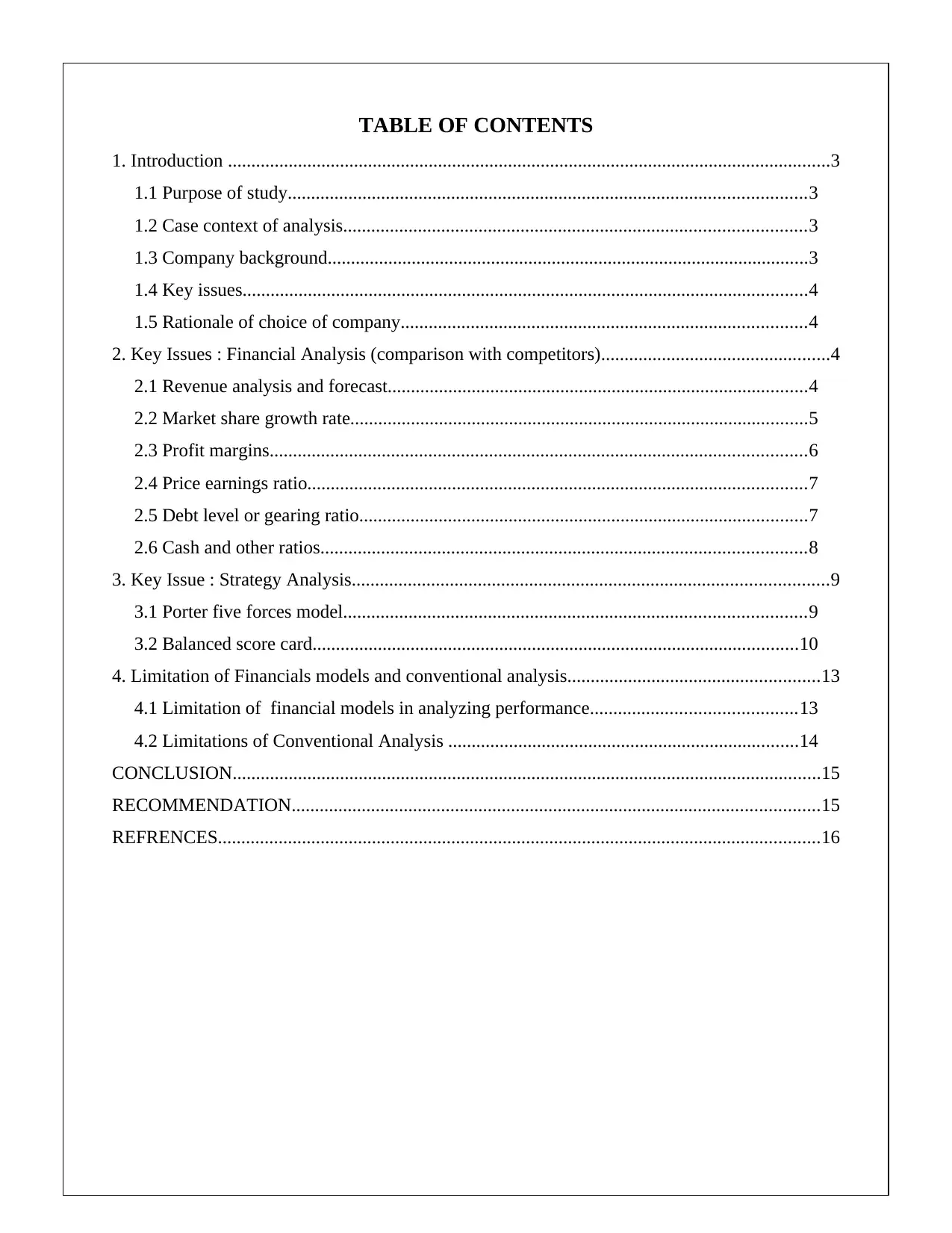
TABLE OF CONTENTS
1. Introduction .................................................................................................................................3
1.1 Purpose of study...............................................................................................................3
1.2 Case context of analysis...................................................................................................3
1.3 Company background.......................................................................................................3
1.4 Key issues.........................................................................................................................4
1.5 Rationale of choice of company.......................................................................................4
2. Key Issues : Financial Analysis (comparison with competitors).................................................4
2.1 Revenue analysis and forecast..........................................................................................4
2.2 Market share growth rate..................................................................................................5
2.3 Profit margins...................................................................................................................6
2.4 Price earnings ratio...........................................................................................................7
2.5 Debt level or gearing ratio................................................................................................7
2.6 Cash and other ratios........................................................................................................8
3. Key Issue : Strategy Analysis......................................................................................................9
3.1 Porter five forces model...................................................................................................9
3.2 Balanced score card........................................................................................................10
4. Limitation of Financials models and conventional analysis......................................................13
4.1 Limitation of financial models in analyzing performance............................................13
4.2 Limitations of Conventional Analysis ...........................................................................14
CONCLUSION..............................................................................................................................15
RECOMMENDATION.................................................................................................................15
REFRENCES.................................................................................................................................16
1. Introduction .................................................................................................................................3
1.1 Purpose of study...............................................................................................................3
1.2 Case context of analysis...................................................................................................3
1.3 Company background.......................................................................................................3
1.4 Key issues.........................................................................................................................4
1.5 Rationale of choice of company.......................................................................................4
2. Key Issues : Financial Analysis (comparison with competitors).................................................4
2.1 Revenue analysis and forecast..........................................................................................4
2.2 Market share growth rate..................................................................................................5
2.3 Profit margins...................................................................................................................6
2.4 Price earnings ratio...........................................................................................................7
2.5 Debt level or gearing ratio................................................................................................7
2.6 Cash and other ratios........................................................................................................8
3. Key Issue : Strategy Analysis......................................................................................................9
3.1 Porter five forces model...................................................................................................9
3.2 Balanced score card........................................................................................................10
4. Limitation of Financials models and conventional analysis......................................................13
4.1 Limitation of financial models in analyzing performance............................................13
4.2 Limitations of Conventional Analysis ...........................................................................14
CONCLUSION..............................................................................................................................15
RECOMMENDATION.................................................................................................................15
REFRENCES.................................................................................................................................16
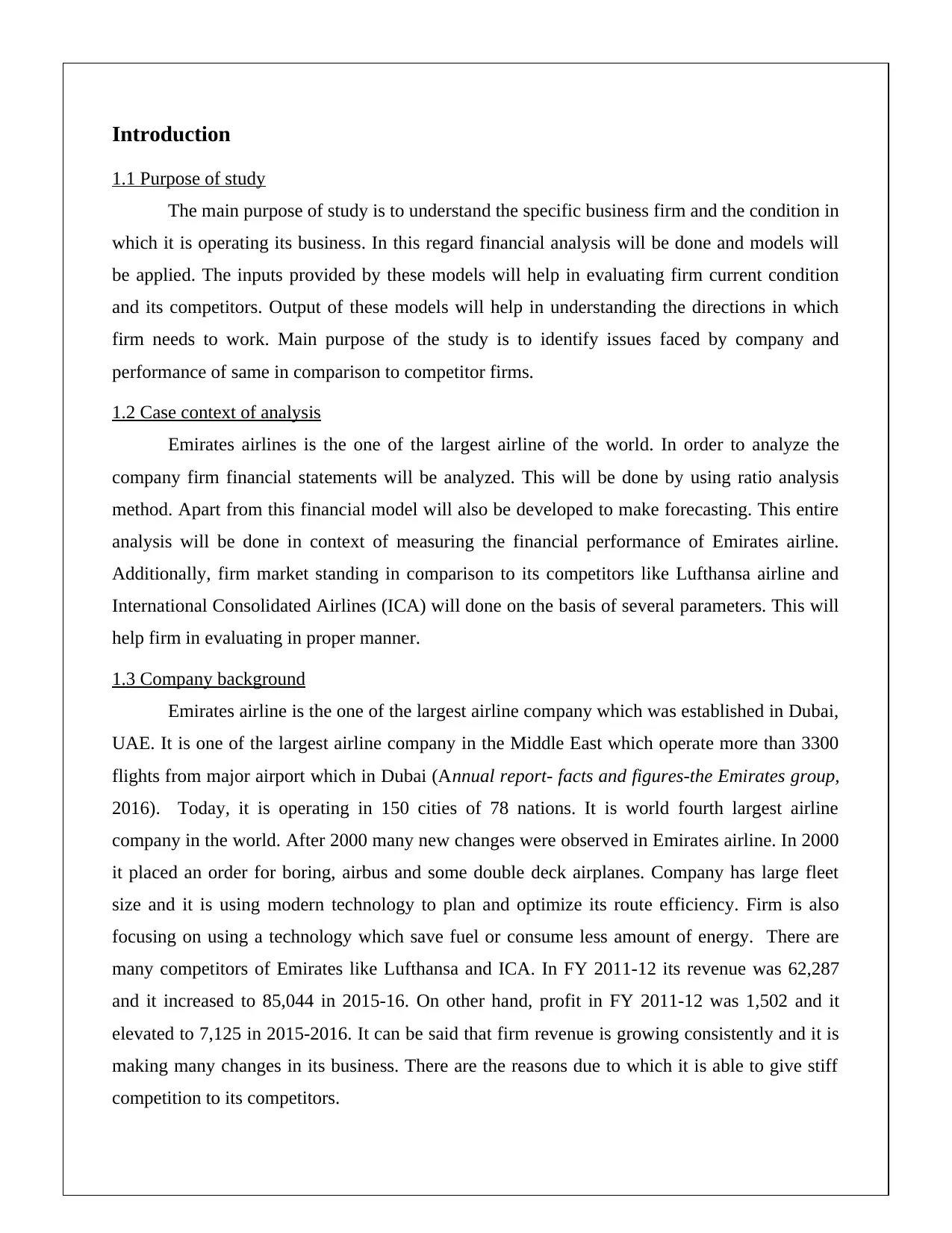
Introduction
1.1 Purpose of study
The main purpose of study is to understand the specific business firm and the condition in
which it is operating its business. In this regard financial analysis will be done and models will
be applied. The inputs provided by these models will help in evaluating firm current condition
and its competitors. Output of these models will help in understanding the directions in which
firm needs to work. Main purpose of the study is to identify issues faced by company and
performance of same in comparison to competitor firms.
1.2 Case context of analysis
Emirates airlines is the one of the largest airline of the world. In order to analyze the
company firm financial statements will be analyzed. This will be done by using ratio analysis
method. Apart from this financial model will also be developed to make forecasting. This entire
analysis will be done in context of measuring the financial performance of Emirates airline.
Additionally, firm market standing in comparison to its competitors like Lufthansa airline and
International Consolidated Airlines (ICA) will done on the basis of several parameters. This will
help firm in evaluating in proper manner.
1.3 Company background
Emirates airline is the one of the largest airline company which was established in Dubai,
UAE. It is one of the largest airline company in the Middle East which operate more than 3300
flights from major airport which in Dubai (Annual report- facts and figures-the Emirates group,
2016). Today, it is operating in 150 cities of 78 nations. It is world fourth largest airline
company in the world. After 2000 many new changes were observed in Emirates airline. In 2000
it placed an order for boring, airbus and some double deck airplanes. Company has large fleet
size and it is using modern technology to plan and optimize its route efficiency. Firm is also
focusing on using a technology which save fuel or consume less amount of energy. There are
many competitors of Emirates like Lufthansa and ICA. In FY 2011-12 its revenue was 62,287
and it increased to 85,044 in 2015-16. On other hand, profit in FY 2011-12 was 1,502 and it
elevated to 7,125 in 2015-2016. It can be said that firm revenue is growing consistently and it is
making many changes in its business. There are the reasons due to which it is able to give stiff
competition to its competitors.
1.1 Purpose of study
The main purpose of study is to understand the specific business firm and the condition in
which it is operating its business. In this regard financial analysis will be done and models will
be applied. The inputs provided by these models will help in evaluating firm current condition
and its competitors. Output of these models will help in understanding the directions in which
firm needs to work. Main purpose of the study is to identify issues faced by company and
performance of same in comparison to competitor firms.
1.2 Case context of analysis
Emirates airlines is the one of the largest airline of the world. In order to analyze the
company firm financial statements will be analyzed. This will be done by using ratio analysis
method. Apart from this financial model will also be developed to make forecasting. This entire
analysis will be done in context of measuring the financial performance of Emirates airline.
Additionally, firm market standing in comparison to its competitors like Lufthansa airline and
International Consolidated Airlines (ICA) will done on the basis of several parameters. This will
help firm in evaluating in proper manner.
1.3 Company background
Emirates airline is the one of the largest airline company which was established in Dubai,
UAE. It is one of the largest airline company in the Middle East which operate more than 3300
flights from major airport which in Dubai (Annual report- facts and figures-the Emirates group,
2016). Today, it is operating in 150 cities of 78 nations. It is world fourth largest airline
company in the world. After 2000 many new changes were observed in Emirates airline. In 2000
it placed an order for boring, airbus and some double deck airplanes. Company has large fleet
size and it is using modern technology to plan and optimize its route efficiency. Firm is also
focusing on using a technology which save fuel or consume less amount of energy. There are
many competitors of Emirates like Lufthansa and ICA. In FY 2011-12 its revenue was 62,287
and it increased to 85,044 in 2015-16. On other hand, profit in FY 2011-12 was 1,502 and it
elevated to 7,125 in 2015-2016. It can be said that firm revenue is growing consistently and it is
making many changes in its business. There are the reasons due to which it is able to give stiff
competition to its competitors.
⊘ This is a preview!⊘
Do you want full access?
Subscribe today to unlock all pages.

Trusted by 1+ million students worldwide
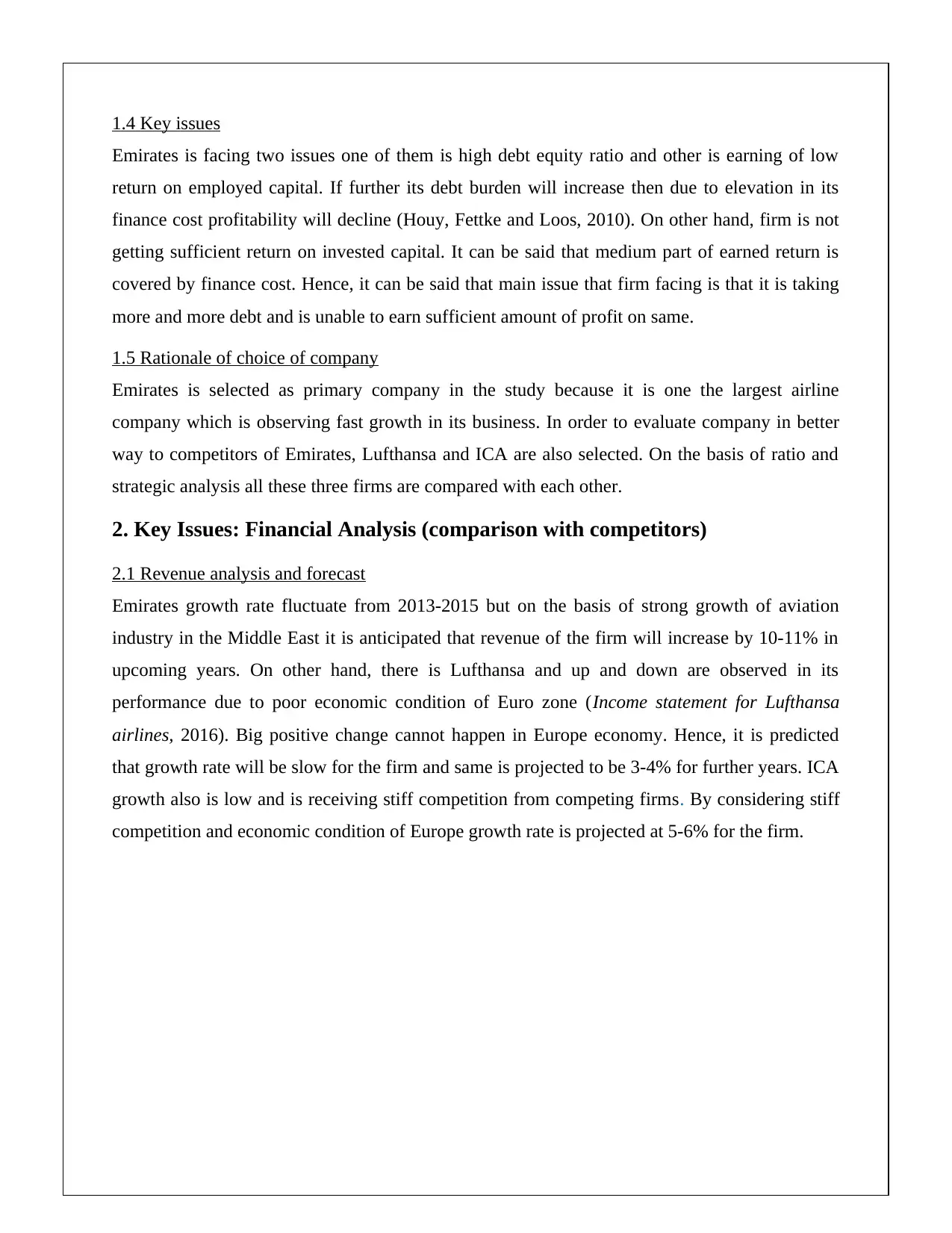
1.4 Key issues
Emirates is facing two issues one of them is high debt equity ratio and other is earning of low
return on employed capital. If further its debt burden will increase then due to elevation in its
finance cost profitability will decline (Houy, Fettke and Loos, 2010). On other hand, firm is not
getting sufficient return on invested capital. It can be said that medium part of earned return is
covered by finance cost. Hence, it can be said that main issue that firm facing is that it is taking
more and more debt and is unable to earn sufficient amount of profit on same.
1.5 Rationale of choice of company
Emirates is selected as primary company in the study because it is one the largest airline
company which is observing fast growth in its business. In order to evaluate company in better
way to competitors of Emirates, Lufthansa and ICA are also selected. On the basis of ratio and
strategic analysis all these three firms are compared with each other.
2. Key Issues: Financial Analysis (comparison with competitors)
2.1 Revenue analysis and forecast
Emirates growth rate fluctuate from 2013-2015 but on the basis of strong growth of aviation
industry in the Middle East it is anticipated that revenue of the firm will increase by 10-11% in
upcoming years. On other hand, there is Lufthansa and up and down are observed in its
performance due to poor economic condition of Euro zone (Income statement for Lufthansa
airlines, 2016). Big positive change cannot happen in Europe economy. Hence, it is predicted
that growth rate will be slow for the firm and same is projected to be 3-4% for further years. ICA
growth also is low and is receiving stiff competition from competing firms. By considering stiff
competition and economic condition of Europe growth rate is projected at 5-6% for the firm.
Emirates is facing two issues one of them is high debt equity ratio and other is earning of low
return on employed capital. If further its debt burden will increase then due to elevation in its
finance cost profitability will decline (Houy, Fettke and Loos, 2010). On other hand, firm is not
getting sufficient return on invested capital. It can be said that medium part of earned return is
covered by finance cost. Hence, it can be said that main issue that firm facing is that it is taking
more and more debt and is unable to earn sufficient amount of profit on same.
1.5 Rationale of choice of company
Emirates is selected as primary company in the study because it is one the largest airline
company which is observing fast growth in its business. In order to evaluate company in better
way to competitors of Emirates, Lufthansa and ICA are also selected. On the basis of ratio and
strategic analysis all these three firms are compared with each other.
2. Key Issues: Financial Analysis (comparison with competitors)
2.1 Revenue analysis and forecast
Emirates growth rate fluctuate from 2013-2015 but on the basis of strong growth of aviation
industry in the Middle East it is anticipated that revenue of the firm will increase by 10-11% in
upcoming years. On other hand, there is Lufthansa and up and down are observed in its
performance due to poor economic condition of Euro zone (Income statement for Lufthansa
airlines, 2016). Big positive change cannot happen in Europe economy. Hence, it is predicted
that growth rate will be slow for the firm and same is projected to be 3-4% for further years. ICA
growth also is low and is receiving stiff competition from competing firms. By considering stiff
competition and economic condition of Europe growth rate is projected at 5-6% for the firm.
Paraphrase This Document
Need a fresh take? Get an instant paraphrase of this document with our AI Paraphraser
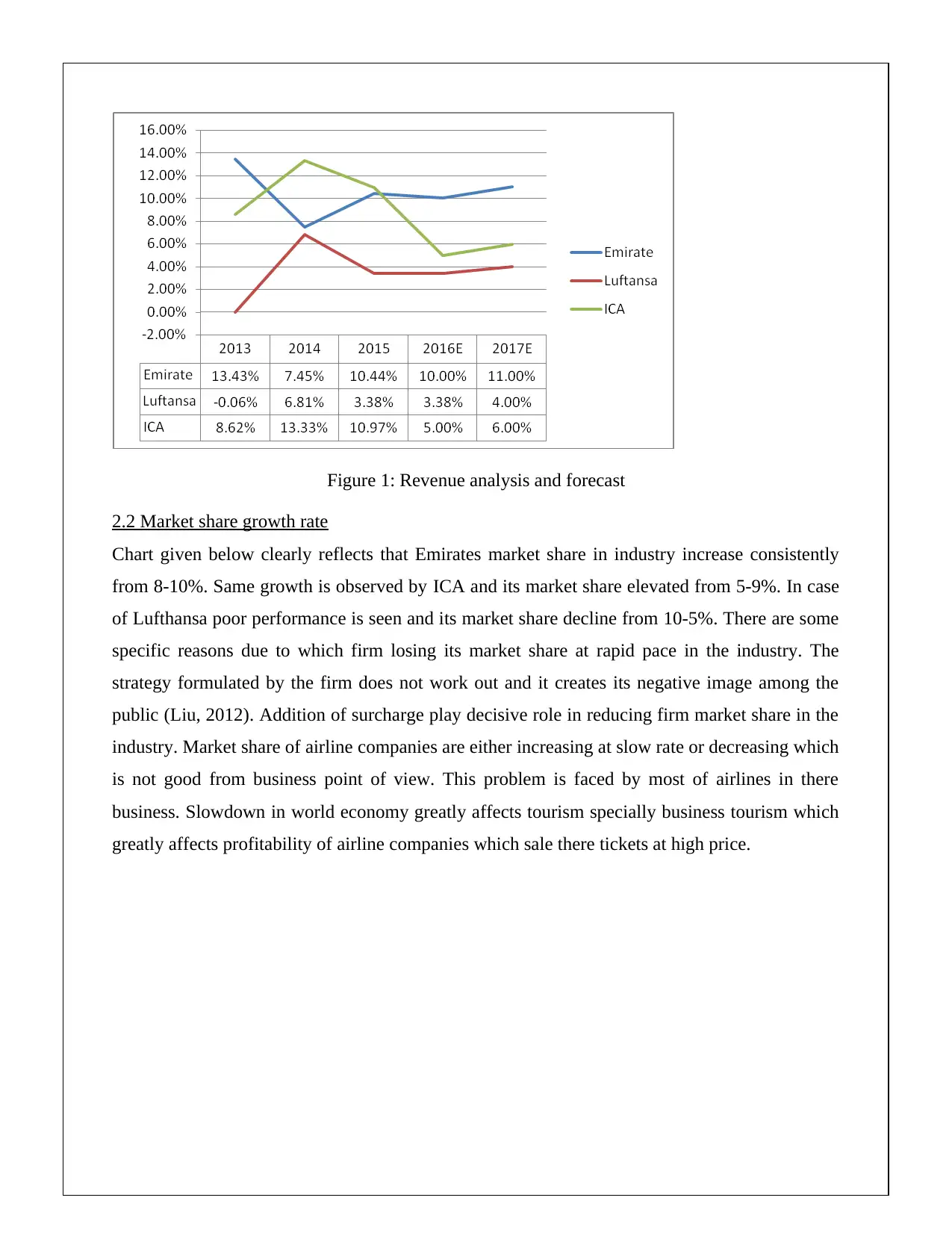
Figure 1: Revenue analysis and forecast
2.2 Market share growth rate
Chart given below clearly reflects that Emirates market share in industry increase consistently
from 8-10%. Same growth is observed by ICA and its market share elevated from 5-9%. In case
of Lufthansa poor performance is seen and its market share decline from 10-5%. There are some
specific reasons due to which firm losing its market share at rapid pace in the industry. The
strategy formulated by the firm does not work out and it creates its negative image among the
public (Liu, 2012). Addition of surcharge play decisive role in reducing firm market share in the
industry. Market share of airline companies are either increasing at slow rate or decreasing which
is not good from business point of view. This problem is faced by most of airlines in there
business. Slowdown in world economy greatly affects tourism specially business tourism which
greatly affects profitability of airline companies which sale there tickets at high price.
2.2 Market share growth rate
Chart given below clearly reflects that Emirates market share in industry increase consistently
from 8-10%. Same growth is observed by ICA and its market share elevated from 5-9%. In case
of Lufthansa poor performance is seen and its market share decline from 10-5%. There are some
specific reasons due to which firm losing its market share at rapid pace in the industry. The
strategy formulated by the firm does not work out and it creates its negative image among the
public (Liu, 2012). Addition of surcharge play decisive role in reducing firm market share in the
industry. Market share of airline companies are either increasing at slow rate or decreasing which
is not good from business point of view. This problem is faced by most of airlines in there
business. Slowdown in world economy greatly affects tourism specially business tourism which
greatly affects profitability of airline companies which sale there tickets at high price.
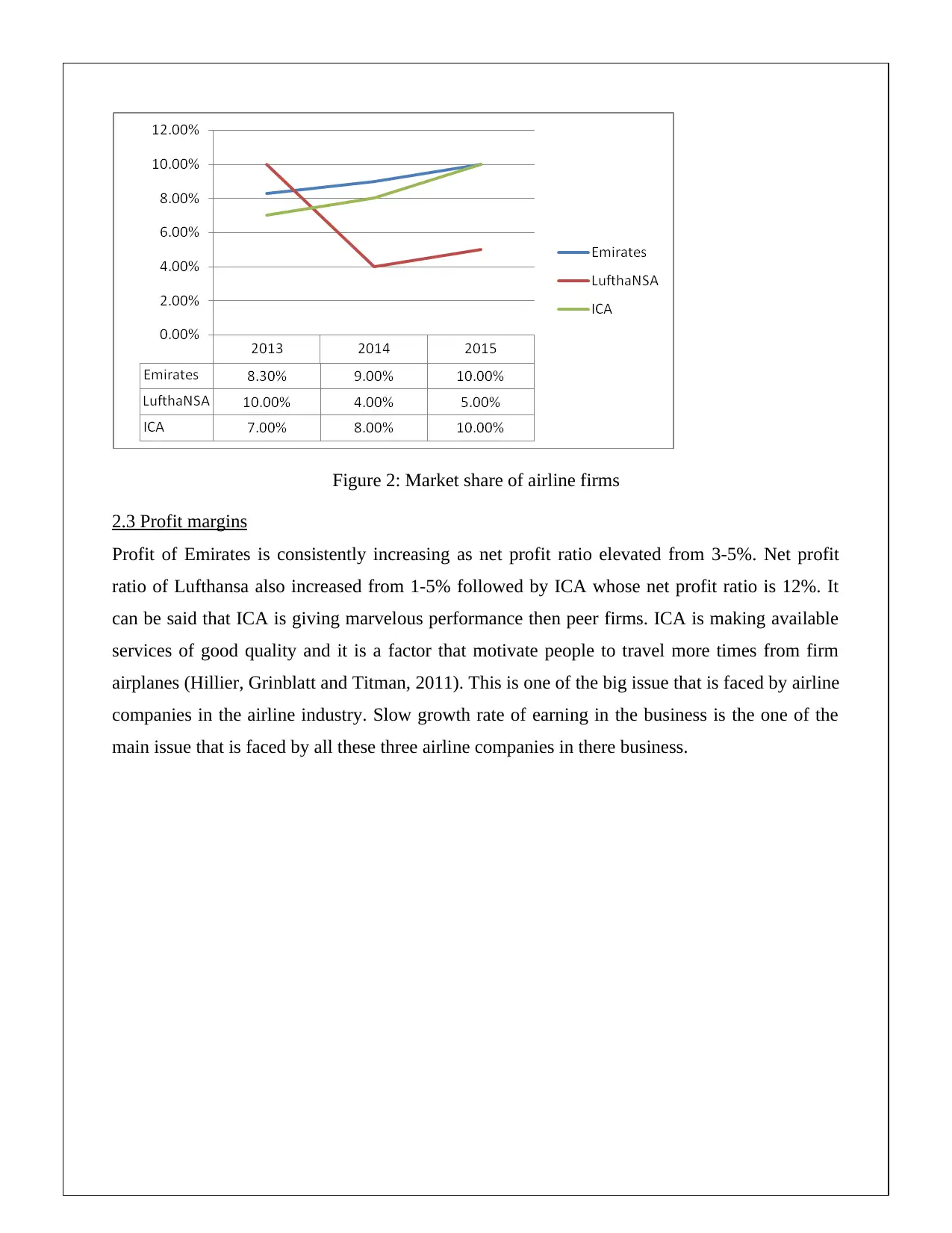
Figure 2: Market share of airline firms
2.3 Profit margins
Profit of Emirates is consistently increasing as net profit ratio elevated from 3-5%. Net profit
ratio of Lufthansa also increased from 1-5% followed by ICA whose net profit ratio is 12%. It
can be said that ICA is giving marvelous performance then peer firms. ICA is making available
services of good quality and it is a factor that motivate people to travel more times from firm
airplanes (Hillier, Grinblatt and Titman, 2011). This is one of the big issue that is faced by airline
companies in the airline industry. Slow growth rate of earning in the business is the one of the
main issue that is faced by all these three airline companies in there business.
2.3 Profit margins
Profit of Emirates is consistently increasing as net profit ratio elevated from 3-5%. Net profit
ratio of Lufthansa also increased from 1-5% followed by ICA whose net profit ratio is 12%. It
can be said that ICA is giving marvelous performance then peer firms. ICA is making available
services of good quality and it is a factor that motivate people to travel more times from firm
airplanes (Hillier, Grinblatt and Titman, 2011). This is one of the big issue that is faced by airline
companies in the airline industry. Slow growth rate of earning in the business is the one of the
main issue that is faced by all these three airline companies in there business.
⊘ This is a preview!⊘
Do you want full access?
Subscribe today to unlock all pages.

Trusted by 1+ million students worldwide
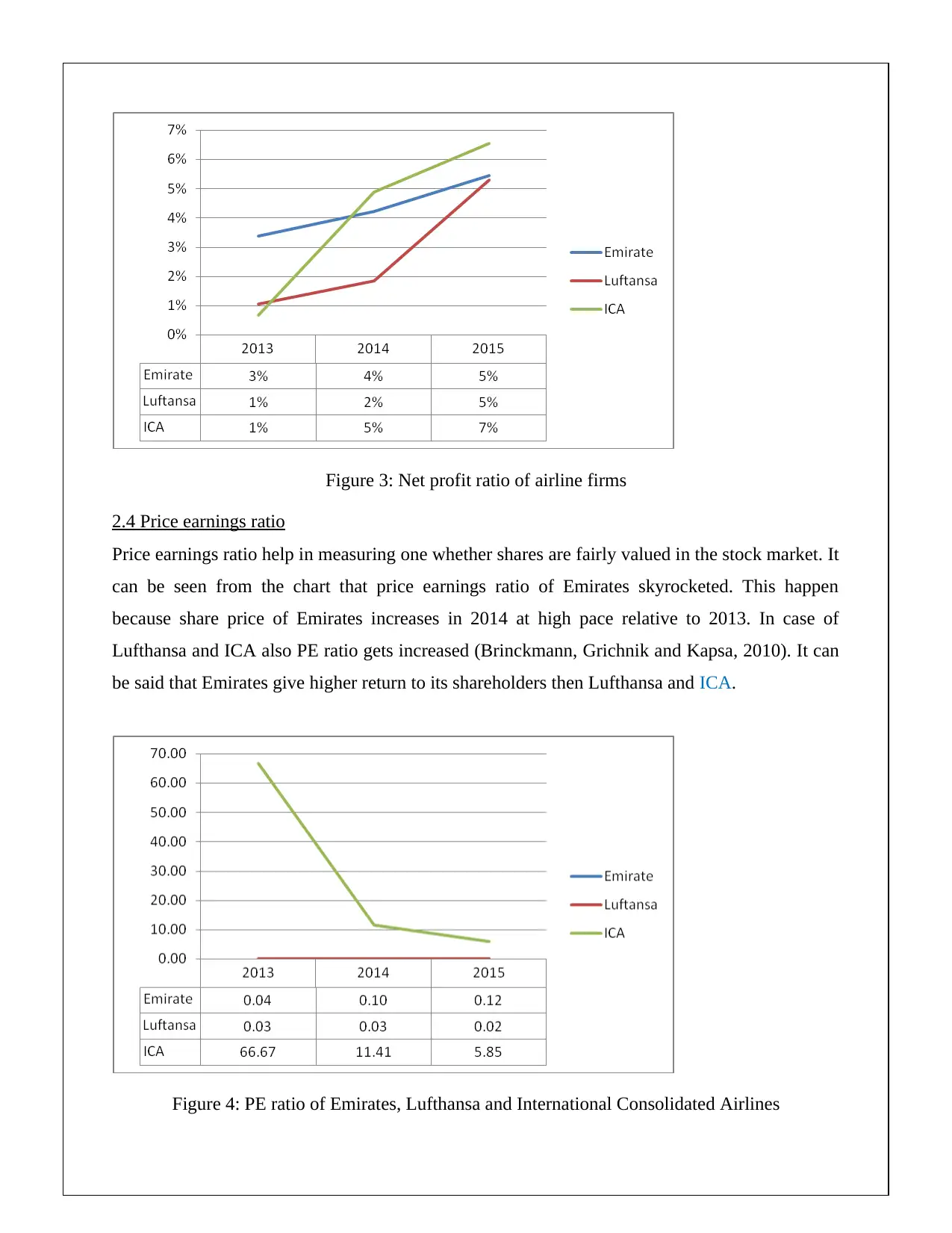
Figure 3: Net profit ratio of airline firms
2.4 Price earnings ratio
Price earnings ratio help in measuring one whether shares are fairly valued in the stock market. It
can be seen from the chart that price earnings ratio of Emirates skyrocketed. This happen
because share price of Emirates increases in 2014 at high pace relative to 2013. In case of
Lufthansa and ICA also PE ratio gets increased (Brinckmann, Grichnik and Kapsa, 2010). It can
be said that Emirates give higher return to its shareholders then Lufthansa and ICA.
Figure 4: PE ratio of Emirates, Lufthansa and International Consolidated Airlines
2.4 Price earnings ratio
Price earnings ratio help in measuring one whether shares are fairly valued in the stock market. It
can be seen from the chart that price earnings ratio of Emirates skyrocketed. This happen
because share price of Emirates increases in 2014 at high pace relative to 2013. In case of
Lufthansa and ICA also PE ratio gets increased (Brinckmann, Grichnik and Kapsa, 2010). It can
be said that Emirates give higher return to its shareholders then Lufthansa and ICA.
Figure 4: PE ratio of Emirates, Lufthansa and International Consolidated Airlines
Paraphrase This Document
Need a fresh take? Get an instant paraphrase of this document with our AI Paraphraser
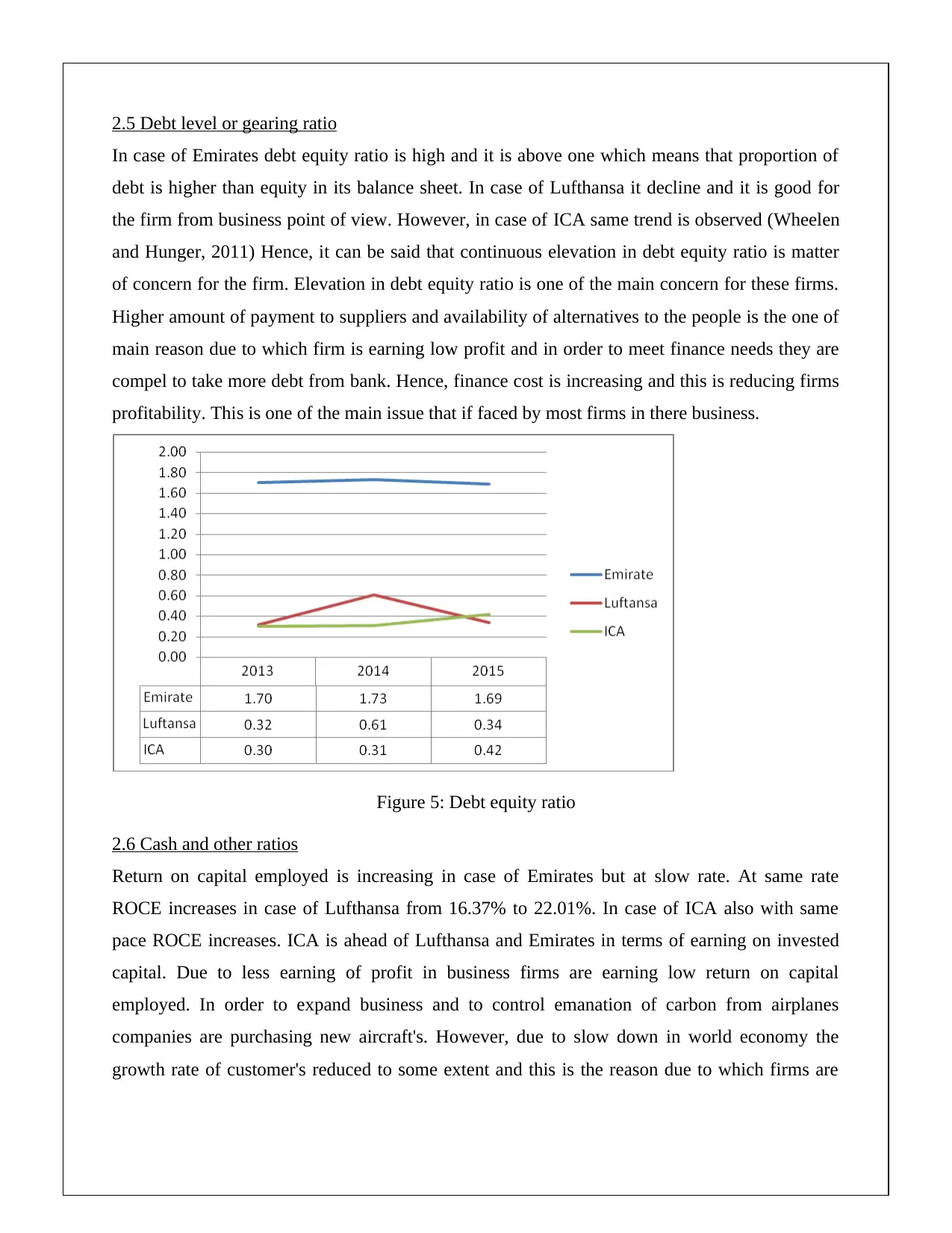
2.5 Debt level or gearing ratio
In case of Emirates debt equity ratio is high and it is above one which means that proportion of
debt is higher than equity in its balance sheet. In case of Lufthansa it decline and it is good for
the firm from business point of view. However, in case of ICA same trend is observed (Wheelen
and Hunger, 2011) Hence, it can be said that continuous elevation in debt equity ratio is matter
of concern for the firm. Elevation in debt equity ratio is one of the main concern for these firms.
Higher amount of payment to suppliers and availability of alternatives to the people is the one of
main reason due to which firm is earning low profit and in order to meet finance needs they are
compel to take more debt from bank. Hence, finance cost is increasing and this is reducing firms
profitability. This is one of the main issue that if faced by most firms in there business.
Figure 5: Debt equity ratio
2.6 Cash and other ratios
Return on capital employed is increasing in case of Emirates but at slow rate. At same rate
ROCE increases in case of Lufthansa from 16.37% to 22.01%. In case of ICA also with same
pace ROCE increases. ICA is ahead of Lufthansa and Emirates in terms of earning on invested
capital. Due to less earning of profit in business firms are earning low return on capital
employed. In order to expand business and to control emanation of carbon from airplanes
companies are purchasing new aircraft's. However, due to slow down in world economy the
growth rate of customer's reduced to some extent and this is the reason due to which firms are
In case of Emirates debt equity ratio is high and it is above one which means that proportion of
debt is higher than equity in its balance sheet. In case of Lufthansa it decline and it is good for
the firm from business point of view. However, in case of ICA same trend is observed (Wheelen
and Hunger, 2011) Hence, it can be said that continuous elevation in debt equity ratio is matter
of concern for the firm. Elevation in debt equity ratio is one of the main concern for these firms.
Higher amount of payment to suppliers and availability of alternatives to the people is the one of
main reason due to which firm is earning low profit and in order to meet finance needs they are
compel to take more debt from bank. Hence, finance cost is increasing and this is reducing firms
profitability. This is one of the main issue that if faced by most firms in there business.
Figure 5: Debt equity ratio
2.6 Cash and other ratios
Return on capital employed is increasing in case of Emirates but at slow rate. At same rate
ROCE increases in case of Lufthansa from 16.37% to 22.01%. In case of ICA also with same
pace ROCE increases. ICA is ahead of Lufthansa and Emirates in terms of earning on invested
capital. Due to less earning of profit in business firms are earning low return on capital
employed. In order to expand business and to control emanation of carbon from airplanes
companies are purchasing new aircraft's. However, due to slow down in world economy the
growth rate of customer's reduced to some extent and this is the reason due to which firms are
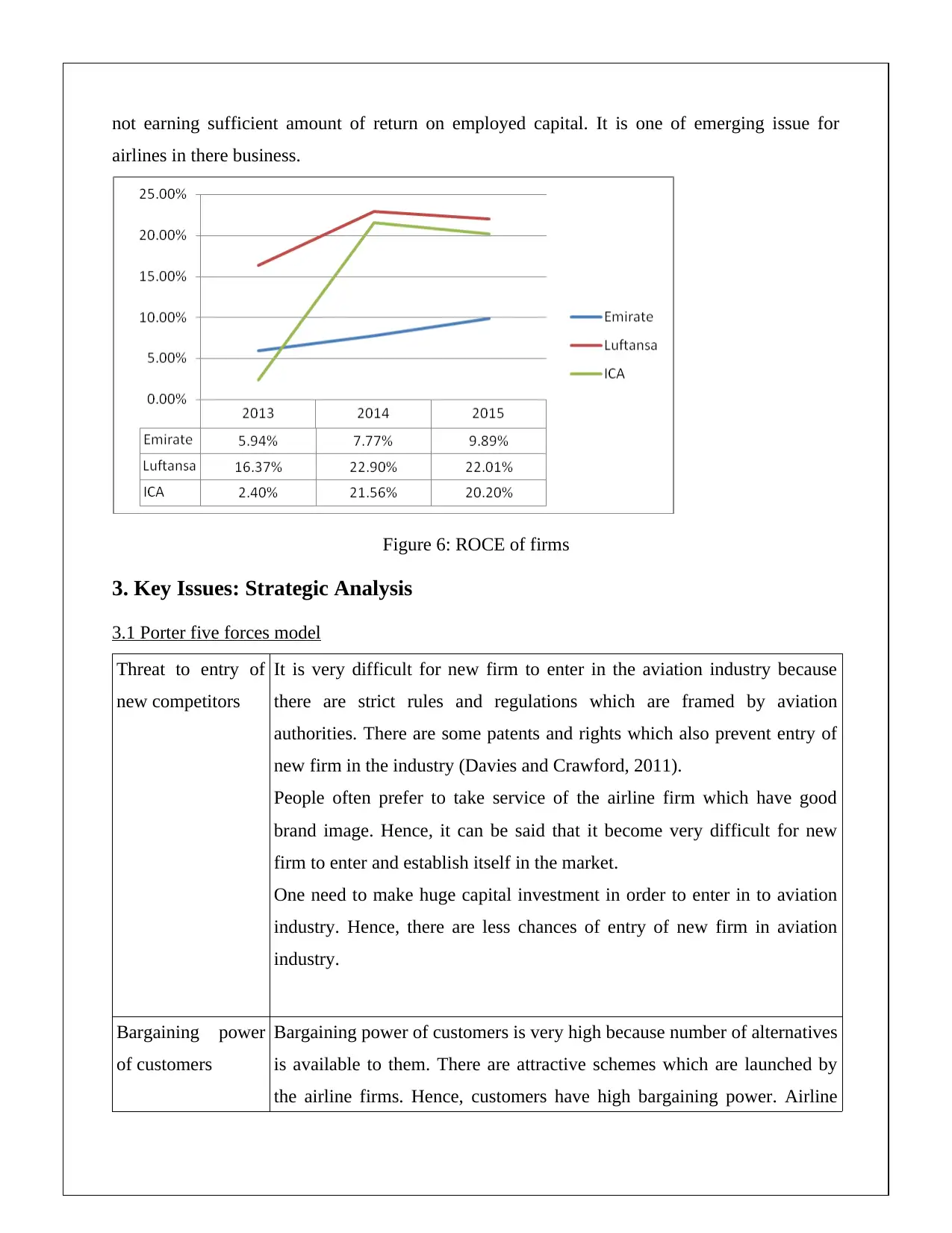
not earning sufficient amount of return on employed capital. It is one of emerging issue for
airlines in there business.
Figure 6: ROCE of firms
3. Key Issues: Strategic Analysis
3.1 Porter five forces model
Threat to entry of
new competitors
It is very difficult for new firm to enter in the aviation industry because
there are strict rules and regulations which are framed by aviation
authorities. There are some patents and rights which also prevent entry of
new firm in the industry (Davies and Crawford, 2011).
People often prefer to take service of the airline firm which have good
brand image. Hence, it can be said that it become very difficult for new
firm to enter and establish itself in the market.
One need to make huge capital investment in order to enter in to aviation
industry. Hence, there are less chances of entry of new firm in aviation
industry.
Bargaining power
of customers
Bargaining power of customers is very high because number of alternatives
is available to them. There are attractive schemes which are launched by
the airline firms. Hence, customers have high bargaining power. Airline
airlines in there business.
Figure 6: ROCE of firms
3. Key Issues: Strategic Analysis
3.1 Porter five forces model
Threat to entry of
new competitors
It is very difficult for new firm to enter in the aviation industry because
there are strict rules and regulations which are framed by aviation
authorities. There are some patents and rights which also prevent entry of
new firm in the industry (Davies and Crawford, 2011).
People often prefer to take service of the airline firm which have good
brand image. Hence, it can be said that it become very difficult for new
firm to enter and establish itself in the market.
One need to make huge capital investment in order to enter in to aviation
industry. Hence, there are less chances of entry of new firm in aviation
industry.
Bargaining power
of customers
Bargaining power of customers is very high because number of alternatives
is available to them. There are attractive schemes which are launched by
the airline firms. Hence, customers have high bargaining power. Airline
⊘ This is a preview!⊘
Do you want full access?
Subscribe today to unlock all pages.

Trusted by 1+ million students worldwide
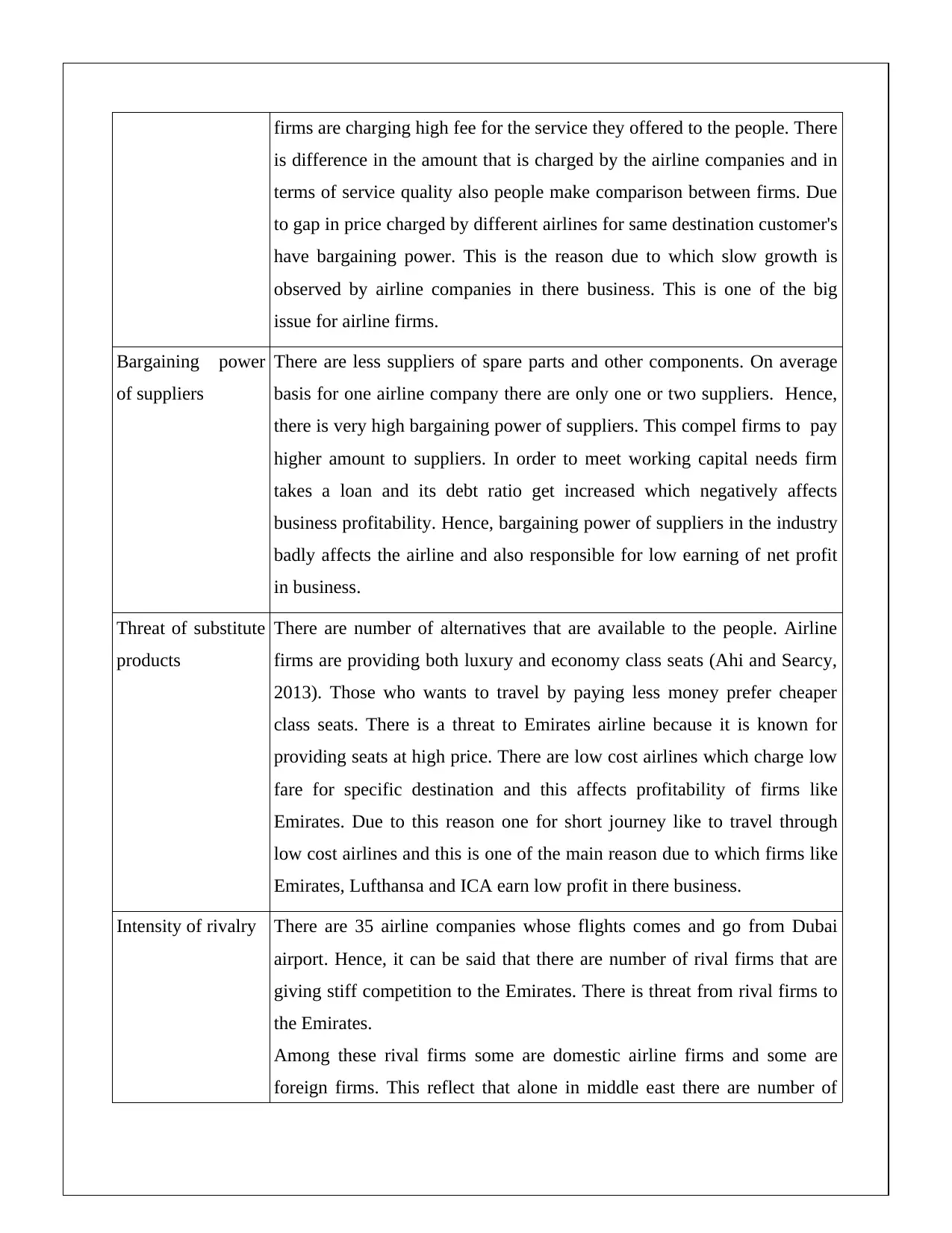
firms are charging high fee for the service they offered to the people. There
is difference in the amount that is charged by the airline companies and in
terms of service quality also people make comparison between firms. Due
to gap in price charged by different airlines for same destination customer's
have bargaining power. This is the reason due to which slow growth is
observed by airline companies in there business. This is one of the big
issue for airline firms.
Bargaining power
of suppliers
There are less suppliers of spare parts and other components. On average
basis for one airline company there are only one or two suppliers. Hence,
there is very high bargaining power of suppliers. This compel firms to pay
higher amount to suppliers. In order to meet working capital needs firm
takes a loan and its debt ratio get increased which negatively affects
business profitability. Hence, bargaining power of suppliers in the industry
badly affects the airline and also responsible for low earning of net profit
in business.
Threat of substitute
products
There are number of alternatives that are available to the people. Airline
firms are providing both luxury and economy class seats (Ahi and Searcy,
2013). Those who wants to travel by paying less money prefer cheaper
class seats. There is a threat to Emirates airline because it is known for
providing seats at high price. There are low cost airlines which charge low
fare for specific destination and this affects profitability of firms like
Emirates. Due to this reason one for short journey like to travel through
low cost airlines and this is one of the main reason due to which firms like
Emirates, Lufthansa and ICA earn low profit in there business.
Intensity of rivalry There are 35 airline companies whose flights comes and go from Dubai
airport. Hence, it can be said that there are number of rival firms that are
giving stiff competition to the Emirates. There is threat from rival firms to
the Emirates.
Among these rival firms some are domestic airline firms and some are
foreign firms. This reflect that alone in middle east there are number of
is difference in the amount that is charged by the airline companies and in
terms of service quality also people make comparison between firms. Due
to gap in price charged by different airlines for same destination customer's
have bargaining power. This is the reason due to which slow growth is
observed by airline companies in there business. This is one of the big
issue for airline firms.
Bargaining power
of suppliers
There are less suppliers of spare parts and other components. On average
basis for one airline company there are only one or two suppliers. Hence,
there is very high bargaining power of suppliers. This compel firms to pay
higher amount to suppliers. In order to meet working capital needs firm
takes a loan and its debt ratio get increased which negatively affects
business profitability. Hence, bargaining power of suppliers in the industry
badly affects the airline and also responsible for low earning of net profit
in business.
Threat of substitute
products
There are number of alternatives that are available to the people. Airline
firms are providing both luxury and economy class seats (Ahi and Searcy,
2013). Those who wants to travel by paying less money prefer cheaper
class seats. There is a threat to Emirates airline because it is known for
providing seats at high price. There are low cost airlines which charge low
fare for specific destination and this affects profitability of firms like
Emirates. Due to this reason one for short journey like to travel through
low cost airlines and this is one of the main reason due to which firms like
Emirates, Lufthansa and ICA earn low profit in there business.
Intensity of rivalry There are 35 airline companies whose flights comes and go from Dubai
airport. Hence, it can be said that there are number of rival firms that are
giving stiff competition to the Emirates. There is threat from rival firms to
the Emirates.
Among these rival firms some are domestic airline firms and some are
foreign firms. This reflect that alone in middle east there are number of
Paraphrase This Document
Need a fresh take? Get an instant paraphrase of this document with our AI Paraphraser
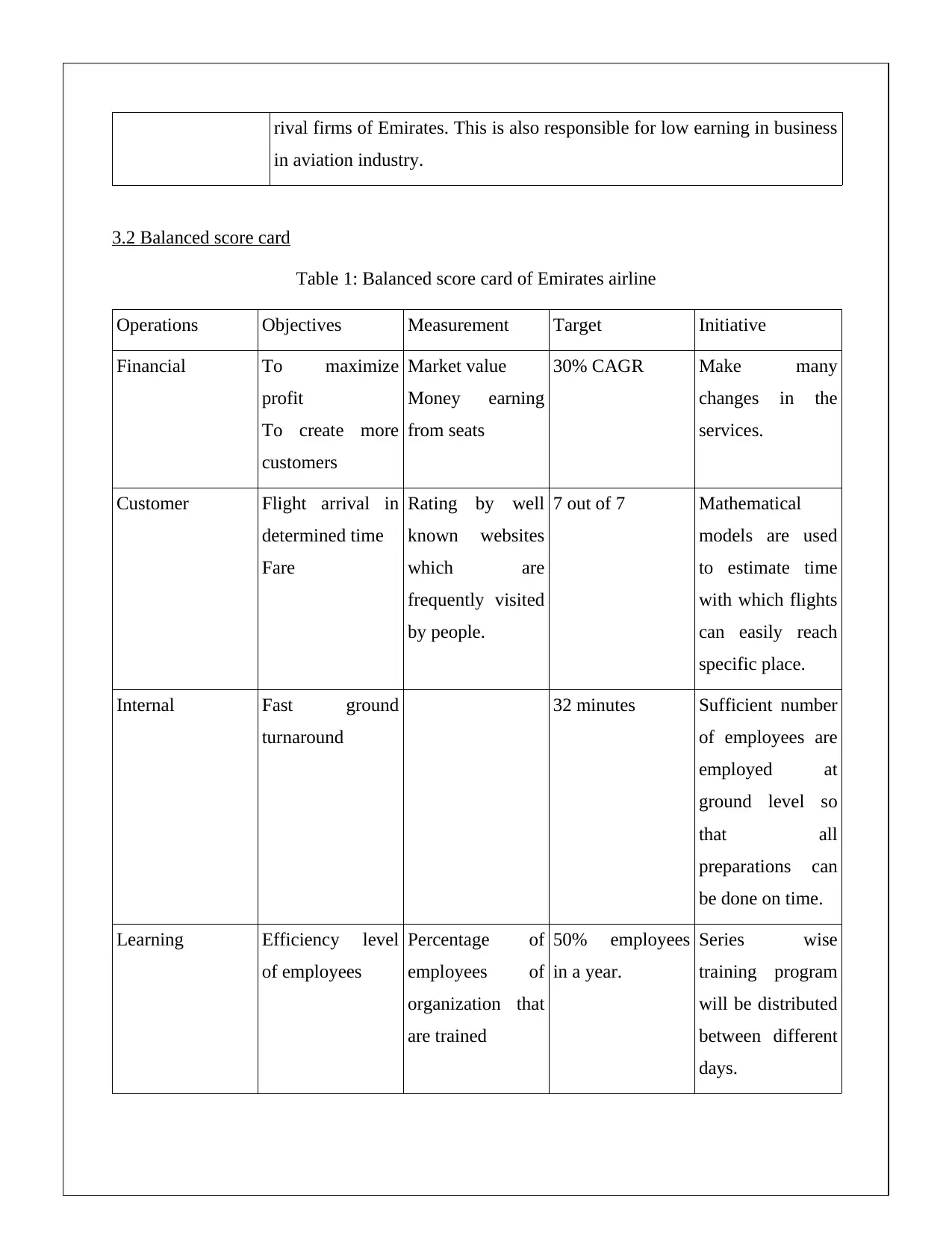
rival firms of Emirates. This is also responsible for low earning in business
in aviation industry.
3.2 Balanced score card
Table 1: Balanced score card of Emirates airline
Operations Objectives Measurement Target Initiative
Financial To maximize
profit
To create more
customers
Market value
Money earning
from seats
30% CAGR Make many
changes in the
services.
Customer Flight arrival in
determined time
Fare
Rating by well
known websites
which are
frequently visited
by people.
7 out of 7 Mathematical
models are used
to estimate time
with which flights
can easily reach
specific place.
Internal Fast ground
turnaround
32 minutes Sufficient number
of employees are
employed at
ground level so
that all
preparations can
be done on time.
Learning Efficiency level
of employees
Percentage of
employees of
organization that
are trained
50% employees
in a year.
Series wise
training program
will be distributed
between different
days.
in aviation industry.
3.2 Balanced score card
Table 1: Balanced score card of Emirates airline
Operations Objectives Measurement Target Initiative
Financial To maximize
profit
To create more
customers
Market value
Money earning
from seats
30% CAGR Make many
changes in the
services.
Customer Flight arrival in
determined time
Fare
Rating by well
known websites
which are
frequently visited
by people.
7 out of 7 Mathematical
models are used
to estimate time
with which flights
can easily reach
specific place.
Internal Fast ground
turnaround
32 minutes Sufficient number
of employees are
employed at
ground level so
that all
preparations can
be done on time.
Learning Efficiency level
of employees
Percentage of
employees of
organization that
are trained
50% employees
in a year.
Series wise
training program
will be distributed
between different
days.
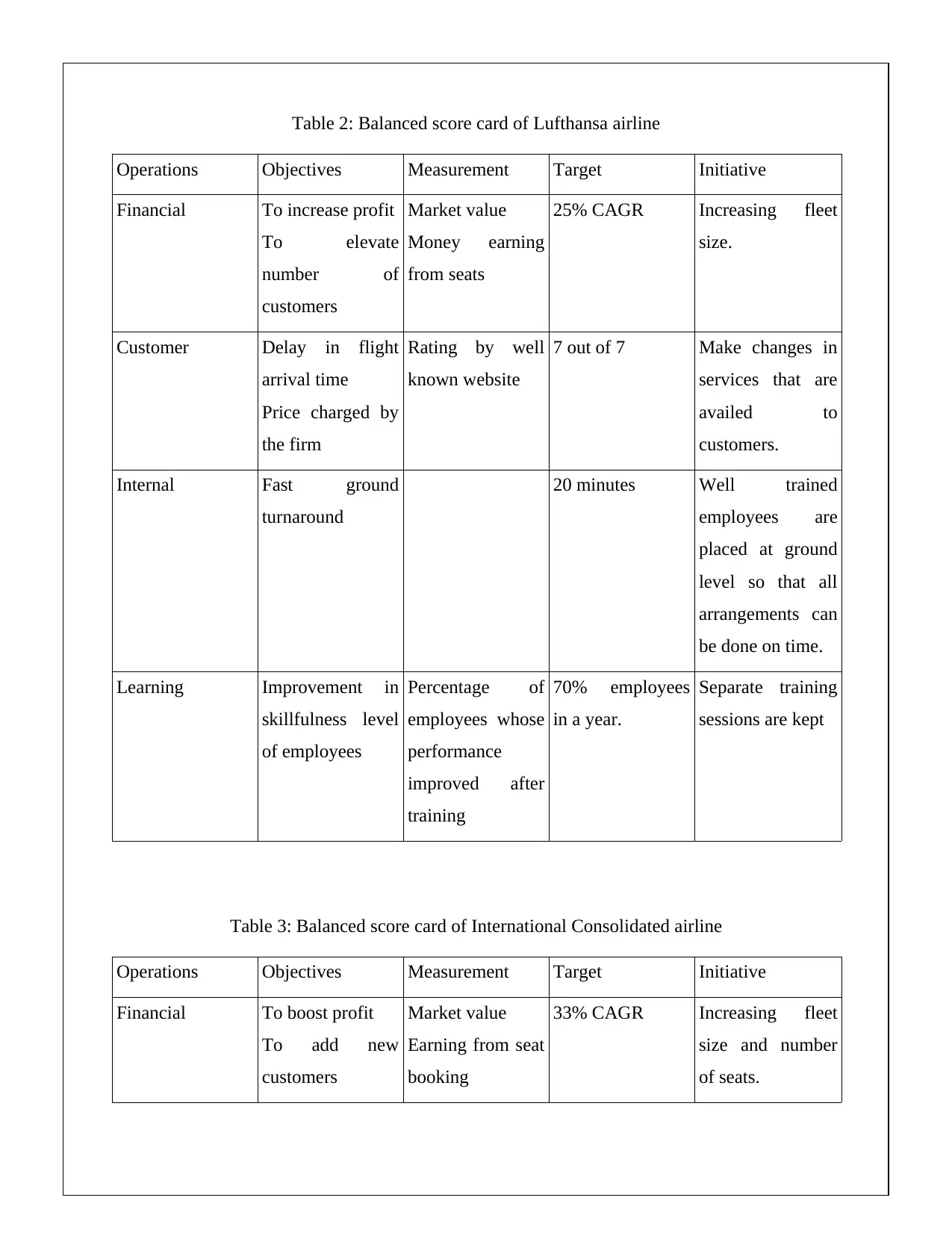
Table 2: Balanced score card of Lufthansa airline
Operations Objectives Measurement Target Initiative
Financial To increase profit
To elevate
number of
customers
Market value
Money earning
from seats
25% CAGR Increasing fleet
size.
Customer Delay in flight
arrival time
Price charged by
the firm
Rating by well
known website
7 out of 7 Make changes in
services that are
availed to
customers.
Internal Fast ground
turnaround
20 minutes Well trained
employees are
placed at ground
level so that all
arrangements can
be done on time.
Learning Improvement in
skillfulness level
of employees
Percentage of
employees whose
performance
improved after
training
70% employees
in a year.
Separate training
sessions are kept
Table 3: Balanced score card of International Consolidated airline
Operations Objectives Measurement Target Initiative
Financial To boost profit
To add new
customers
Market value
Earning from seat
booking
33% CAGR Increasing fleet
size and number
of seats.
Operations Objectives Measurement Target Initiative
Financial To increase profit
To elevate
number of
customers
Market value
Money earning
from seats
25% CAGR Increasing fleet
size.
Customer Delay in flight
arrival time
Price charged by
the firm
Rating by well
known website
7 out of 7 Make changes in
services that are
availed to
customers.
Internal Fast ground
turnaround
20 minutes Well trained
employees are
placed at ground
level so that all
arrangements can
be done on time.
Learning Improvement in
skillfulness level
of employees
Percentage of
employees whose
performance
improved after
training
70% employees
in a year.
Separate training
sessions are kept
Table 3: Balanced score card of International Consolidated airline
Operations Objectives Measurement Target Initiative
Financial To boost profit
To add new
customers
Market value
Earning from seat
booking
33% CAGR Increasing fleet
size and number
of seats.
⊘ This is a preview!⊘
Do you want full access?
Subscribe today to unlock all pages.

Trusted by 1+ million students worldwide
1 out of 23
Related Documents
Your All-in-One AI-Powered Toolkit for Academic Success.
+13062052269
info@desklib.com
Available 24*7 on WhatsApp / Email
![[object Object]](/_next/static/media/star-bottom.7253800d.svg)
Unlock your academic potential
Copyright © 2020–2025 A2Z Services. All Rights Reserved. Developed and managed by ZUCOL.





